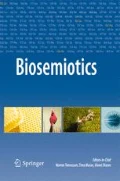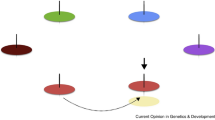Abstract
Darwinian evolution, as it was first conceived, has two dimensions: adaptation, that is, selection based upon “apt function”, defined as the “good fit” between an organism’s metabolic and biological demands and the environment in which it is embedded; and heredity, the transmissible memory of past apt function. Modern Darwinism has come to focus almost exclusively on hereditary memory, eclipsing the—arguably still-problematic—phenomenon of adaptation. As a result, modern Darwinism retains, at its core, certain incoherencies that, as long as they remain unresolved, preclude the emergence of a fully-coherent theory of evolution. Resolving the incoherencies will involve clarifying the relationship between embodied memory and apt function. In short, adaptation is a problem of semiotics: the organism must interpret the environment to fit well into it. This is well-illustrated by the constructed environments built by colonies of social insects, such as hives or nests, and the ancillary structures that contain them, forming an organism-like system known as a superorganism. The superorganism is marked by a kind of extended physiology, in that these constructed environments often serve as adaptive interfaces between the nest and ambient environment, and are constructed to manage the matter and energy flows between environments that constitute the process of adaptation. These constructed environments are also semiotic phenomena: interpretive structures, governed by information flow between the member insects and the structures they build. I review our findings on one such example: the mounds built by the fungus-cultivating termites of the genus Macrotermes. These structures are dynamic forms that are sustained by flows of soil from deep horizons up into the mound. The form, and hence the function, of the mound is determined by several environmental cues, most notably water and wind, as well as how termites interpret these cues, and signals that flow between termites, both directly and vicariously through the structures they build.




Similar content being viewed by others
References
Aanen, D. K., Eggleton, P., Rouland-Lefèvre, C., Guldberg-Frøslev, T., Rosendahl, S., & Boomsma, J. J. (2002). The evolution of fungus-growing termites and their mutualistic fungal symbionts. Proceedings of the National Academy of Sciences of the United States of America, 99(23), 14887–14892.
Arshad, M. A. (1982). Influence of the termite Macrotermes michaelseni (Sjöst) on soil fertility and vegetation in a semi-arid savannah ecosystem. Agro-Ecosystems, 8, 47–58.
Batra, L. K., & Batra, S. W. T. (1966). Fungus-growing termites of tropical India and associated fungi. Journal of the Kansas Entomological Society, 39, 725–738.
Bonabeau, E., Dorigo, M., & Theraulaz, G. (1999). Swarm Intelligence. In From Natural to Artificial Systems (Studies in the Sciences of Complexity). New York: Oxford University Press.
Bowler, P. J. (1983). The Eclipse of Darwinism. Anti-Darwinian Evolution Theories in the Decades around 1900. Baltimore, Maryland: The Johns Hopkins University Press.
Buss, L. W. (1987). The Evolution of Individuality. Princeton, New Jersey: Princeton University Press.
Collins, N. M. (1981). Populations, age structure and survivorship of colonies of Macrotermes bellicosus (Isoptera: Macrotermitinae). Journal of Animal Ecology, 50(1), 293–311.
Darlington, J. P. E. C. (1985). The structure of mature mounds of the termite Macrotermes michaelseni in Kenya. Insect Science and its Application, 6(2), 149–156.
Darlington, J. P. E. C. (1988). Multiple reproductives in nests of Macrotermes herus (Isoptera: Termitidae). Sociobiology, 14(2), 347–351.
Darlington, J. P. E. C. (1994). Nutrition and evolution in fungus-growing termites. In J. H. Hunt & C. A. Nalepa (Eds.), Nourishment and Evolution in Insect Societies (pp. 105–130). Boulder, Colorado: Westview Press.
Darlington, J. P. E. C., & Dransfield, R. D. (1987). Size relationships in nest populations and mound parameters in the termite Macrotermes michaelseni in Kenya. Insectes Sociaux, 34(3), 165–180.
Darlington, J. P. E. C., Zimmerman, P. R., & Wandiga, S. O. (1992). Populations in nests of the termite Macrotermes jeanneli in Kenya. Journal of Tropical Ecology, 8, 73–85.
Darlington, J. P. E. C., Zimmerman, P. R., Greenberg, J., Westberg, C., & Bakwin, P. (1997). Production of metabolic gases by nests of the termite Macrotermes jeaneli in Kenya. Journal of Tropical Ecology, 13, 491–510.
Gilbert, S. F., & Epel, D. (2009). Ecological Developmental Biology: Integrating Epigenetics, Medicine, and Evolution. Sunderland, Massachusetts: Sinauer Associates.
Grassé, P.-P. (1959). La reconstruction du nid et les coordinations inter-individuelles chez Bellicositermes et Cubitermes sp. La théorie de la stigmergie: Essai d'interprétationdu comportement des termites constructeurs. Insectes Sociaux, 6, 41–80.
Hoffmeyer, J. (2008). Biosemiotics: an examination into the signs of life and the life of signs (Vol. 2, Approaches to postmodernity, Vol. Book, Whole). Scranton: University of Scranton Press.
Jablonka, E., & Lamb, M. J. (1998). Epigenetic inheritance in evolution. Journal of Evolutionary Biology, 11, 159–183.
Jacklyn, P. M., & Munro, U. (2002). Evidence for the use of magnetic cues in mound construction by the termite Amitermes meridionalis (Isoptera: Termitinae). Australian Journal of Zoology, 50(4), 357–368.
Kandel, E. R., Schwartz, J. H., & Jessell, T. M. (Eds.) (1991). Principles of Neural Science. New York: Elsevier.
Kennedy, J., & Eberhart, R. C. (2001). Swarm Intelligence. New York: Academic Press.
Korb, J. (2003). The shape of compass termite mounds and its biological significance. Insectes Sociaux, 50(3), 218–221. doi:10.1007/s00040-003-0668-2.
Korb, J., & Linsenmair, K. E. (2000). Ventilation of termite mounds: New results require a new model. Behavioral Ecology, 11(5), 486–494.
Kowalski, G. J., & Mitchell, J. W. (1976). Heat transfer from spheres in the naturally turbulent outdoor environments. Journal of Heat Transfer, 98, 649–653.
Kull, K. (1999). Biosemiotics in the twentieth century: a view from biology. Semiotica, 127(1/4), 385–414.
Lüscher, M. (1961). Air conditioned termite nests. Scientific American, 205(1), 138–145.
Mueller, U. G. (1991). Haplodiploidy and the evolution of facultative sex ratios in a primitively eusocial bee. Science, 254, 442–444.
Shanahan, T. (2004). The Evolution of Darwinism: Selection, Adaptation and Progress in Evolution. Cambridge, UK: Cambridge University Press.
Turner, J. S. (2000a). Architecture and morphogenesis in the mound of Macrotermes michaelseni (Sjostedt) (Isoptera: Termitidae, Macrotermitinae) in northern Namibia. Cimbebasia, 16, 143–175.
Turner, J. S. (2000b). The Extended Organism. The Physiology of Animal-Built Structures. Cambridge: Harvard University Press.
Turner, J. S. (2001). On the mound of Macrotermes michaelseni as an organ of respiratory gas exchange. Physiological and Biochemical Zoology, 74(6), 798–822. doi:10.1086/323990.
Turner, J. S. (2004). Extended phenotypes and extended organisms. Biology and Philosophy, 19(3), 327–352.
Turner, J. S. (2005). Extended physiology of an insect-built structure. American Entomologist, 51(1), 36–38.
Turner, J. S. (2007). The Tinkerer's Accomplice. How Design Emerges from Life Itself. Cambridge, Massachusetts: Harvard University Press.
Turner, J. S. (2011). Termites as models of swarm cognition. Swarm Intelligence, 5(1), 19–43. doi:10.1007/s11721-010-0049-1.
Turner, J. S., & Soar, R. C. (2008). Beyond biomimicry: What termites can tell us about realizing the living building. In I. Wallis, L. Bilan, M. Smith, & A. S. Kazi (Eds.), Industrialised, Integrated, Intelligent sustainable Construction (pp. 233–248). London: I3CON BSRIA.
Turner, J. S., Marais, E., Vinte, M., Mudengi, A., & Park, W. (2006). Termites, water and soils. Agricola, 2006(16), 40–45.
Uexküll, J. V. (1909). Umwelt und Innenwelt der Tiere. Berlin: J Springer.
Wilson, E. O. (1971a). The Insect Societies. Cambridge, Massachusetts: Belknap/Harvard University Press.
Wilson, E. O. (1971b). The termites. The Insect Societies (pp. 103–119). Cambridge, Massachusetts: Belknap Press of the Harvard University Press.
Acknowledgments
This essay is abstracted from a forthcoming book, which the John C. Templeton Foundation has generously supported. Their support included a stint as a Visiting Scholar at Cambridge University under the generous hospitality of Prof Simon Conway Morris and St John’s College. Original research reported here was supported by grants from the National Science Foundation, the National Geographic Society and the United States Army Research Office.
Author information
Authors and Affiliations
Corresponding author
Rights and permissions
About this article
Cite this article
Turner, J.S. Semiotics of a Superorganism. Biosemiotics 9, 85–102 (2016). https://doi.org/10.1007/s12304-016-9256-5
Received:
Accepted:
Published:
Issue Date:
DOI: https://doi.org/10.1007/s12304-016-9256-5




